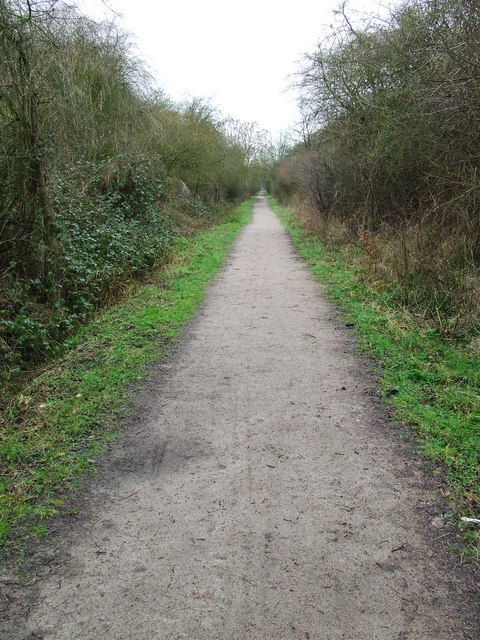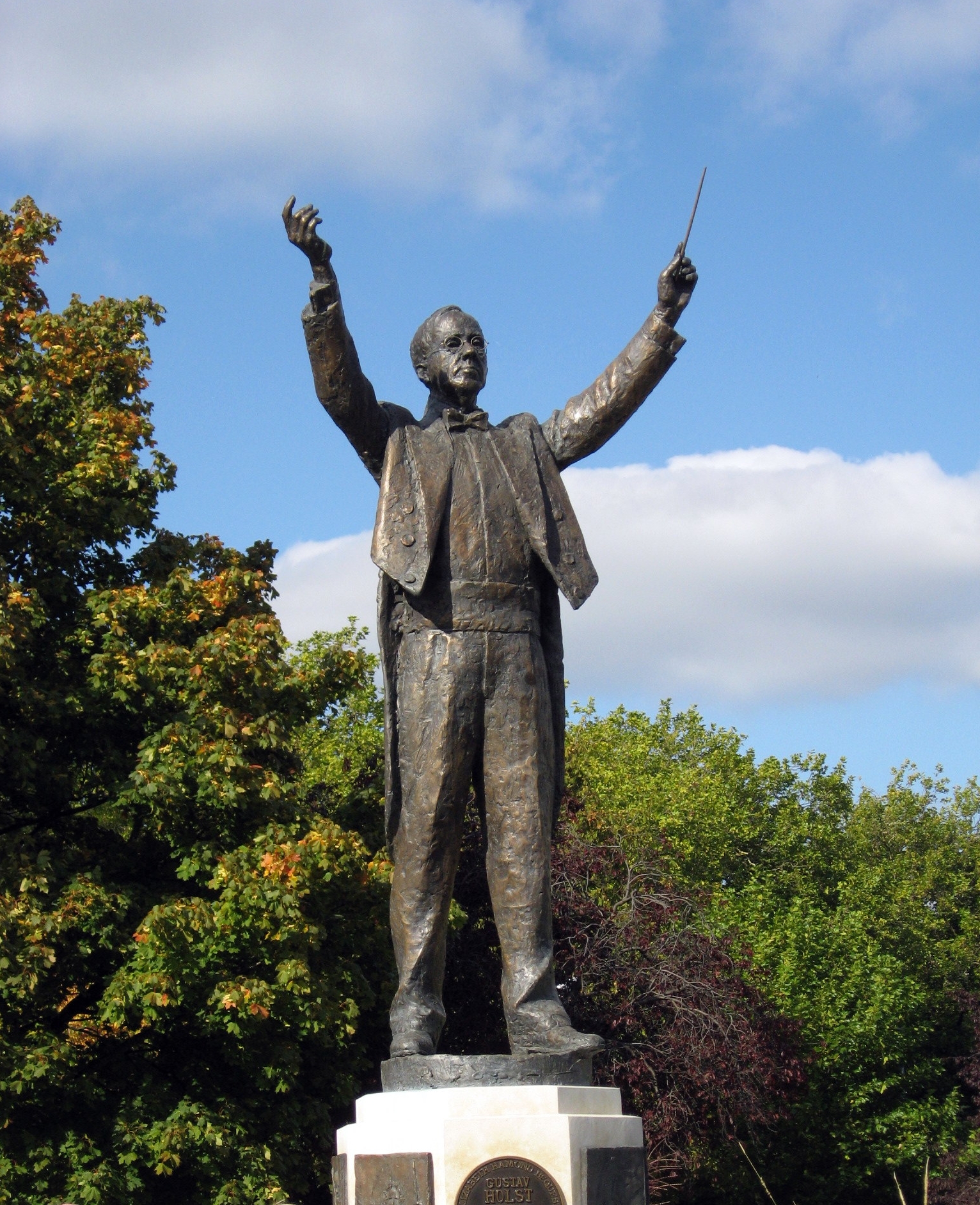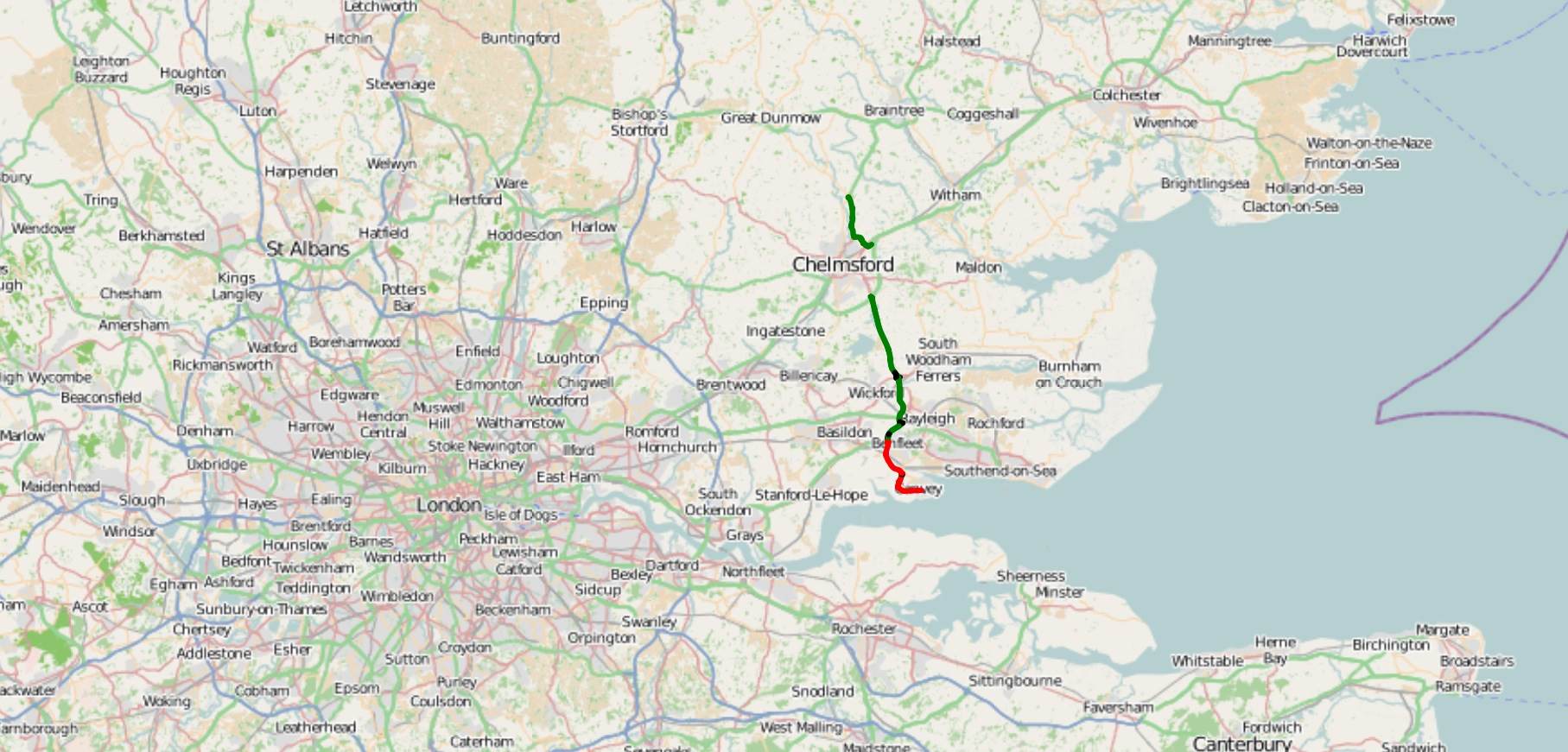|
Monk Street
Monk Street is a hamlet in the civil parish of Thaxted, in the Uttlesford district of Essex, England. It is south of the town of Thaxted, on the main B184 road to Great Dunmow. The name of the hamlet is probably linked to the former Cistercian abbey in nearby Tilty. The composer Gustav Holst rented a thatched cottage in Monk Street from his friend Samuel Bensusan in 1915. It was whilst staying in this cottage that Holst worked on ''The Planets ''The Planets'', Op. 32, is a seven- movement orchestral suite by the English composer Gustav Holst, written between 1914 and 1917. In the last movement the orchestra is joined by a wordless female chorus. Each movement of the suite is name ...'' suite. In 1917 Holst moved to a house in Town Street, Thaxted. The cottage, which dated from 1614, burnt down in the early 1940s. The main A130 trunk road once passed through the centre of the hamlet, but it was bypassed by a road straightening and widening scheme in the 1960s. Refer ... [...More Info...] [...Related Items...] OR: [Wikipedia] [Google] [Baidu] |
Thaxted
Thaxted is a town and civil parish in the Uttlesford district of north-west Essex, England. The town is in the valley of the River Chelmer, not far from its source in the nearby village of Debden, and is 97 metres (318 feet) above sea level (where the parish church stands). The town is north from the county town of Chelmsford and east from the M11 motorway. The parish contains the hamlets of Cutlers Green, Bardfield End Green, Sibleys Green, Monk Street and Richmond's Green. Much of its status as a "town" rests on its prominent late medieval guildhall, a place where guilds of skilled tradesmen regulated their trading practices, and its English Perpendicular parish church. History According to ''A Dictionary of British Place Names'', Thaxted derives from the Old English ''thoec'' or ''þæc'' combined with ''stede'', being a "place where thatching materials are got". In the 1086 ''Domesday Book,'' the settlement is referred to as 'Tachesteda' and in subsequent official ... [...More Info...] [...Related Items...] OR: [Wikipedia] [Google] [Baidu] |
Uttlesford
Uttlesford is a Non-metropolitan district, local government district in Essex, England. Its council is based in the town of Saffron Walden. The district also includes the town of Great Dunmow and numerous villages, including Stansted Mountfitchet, Takeley, Elsenham, Thaxted, and Newport, Essex, Newport. The district covers a largely rural area in the north-west of Essex. London Stansted Airport lies within the district. The neighbouring districts are Braintree District, Braintree, City of Chelmsford, Chelmsford, Epping Forest District, Epping Forest, East Hertfordshire, North Hertfordshire and South Cambridgeshire. History The district was formed on 1 April 1974 under the Local Government Act 1972 as one of 14 districts within Essex. The new district covered the area of three former districts, which were all abolished at the same time: *Dunmow Rural District *Saffron Walden Municipal Borough *Saffron Walden Rural District The new district was named after the ancient hundred (cou ... [...More Info...] [...Related Items...] OR: [Wikipedia] [Google] [Baidu] |
Essex
Essex ( ) is a Ceremonial counties of England, ceremonial county in the East of England, and one of the home counties. It is bordered by Cambridgeshire and Suffolk to the north, the North Sea to the east, Kent across the Thames Estuary to the south, Greater London to the south-west, and Hertfordshire to the west. The largest settlement is Southend-on-Sea, and the county town is Chelmsford. The county has an area of and a population of 1,832,751. After Southend-on-Sea (182,305), the largest settlements are Colchester (130,245), Basildon (115,955) and Chelmsford (110,625). The south of the county is very densely populated, and the remainder, besides Colchester and Chelmsford, is largely rural. For local government purposes Essex comprises a non-metropolitan county, with twelve districts, and two unitary authority areas: Thurrock Council, Thurrock and Southend-on-Sea City Council, Southend-on-Sea. The districts of Chelmsford, Colchester and Southend have city status. The county H ... [...More Info...] [...Related Items...] OR: [Wikipedia] [Google] [Baidu] |
Great Dunmow
Great Dunmow is a historic market town and civil parish in the Uttlesford district of Essex, England. It lies to the north of the A120 road, approximately midway between Bishop's Stortford and Braintree, Essex, Braintree, east of London Stansted Airport. Originally the site of a Roman Britain, Roman settlement on Stane Street (Colchester), Stane Street, the town thrived during the Middle Ages. Dunmow means "Meadow on the Hill". The settlement was variously referred to as Dunmow Magna, Much Dunmow, or most commonly Great Dunmow. History A Roman small town developed on the junction between Stane Street (Colchester), Stane Street and the Roman roads in Britannia, Roman roads which ran northeast to southwest from Sudbury, Suffolk, Sudbury to London, and northwest to southeast from Cambridge to Chelmsford. The main settlement area spread westwards from the road junction, with cemeteries on the outskirts. There was a second Roman settlement at Church End immediately to the north of ... [...More Info...] [...Related Items...] OR: [Wikipedia] [Google] [Baidu] |
Cistercians
The Cistercians (), officially the Order of Cistercians (, abbreviated as OCist or SOCist), are a Catholic religious order of monks and nuns that branched off from the Benedictines and follow the Rule of Saint Benedict, as well as the contributions of the highly influential Bernard of Clairvaux, known as the Latin Rule. They are also known as Bernardines, after Bernard of Clairvaux, Saint Bernard, or as White Monks, in reference to the colour of their cowl, as opposed to the black cowl worn by Benedictines. The term ''Cistercian'' derives from ''Cistercium,'' the Latin name for the locale of Cîteaux, near Dijon in eastern France. It was here that a group of Benedictine monks from the monastery of Molesme Abbey, Molesme founded Cîteaux Abbey in 1098. The first three abbots were Robert of Molesme, Alberic of Cîteaux and Stephen Harding. Bernard helped launch a new era when he entered the monastery in the early 1110s with 30 companions. By the end of the 12th century, the ord ... [...More Info...] [...Related Items...] OR: [Wikipedia] [Google] [Baidu] |
Tilty Abbey
Tilty Abbey was a Cistercian abbey in Tilty, Essex, England. It was dissolved 3 March 1536. The chapel, with a nave The nave () is the central part of a church, stretching from the (normally western) main entrance or rear wall, to the transepts, or in a church without transepts, to the chancel. When a church contains side aisles, as in a basilica-type ... built circa 1220, became a parish church and has survived, with later alterations and extensions. An order taken at the late monastery of Tiltey, 3 March 27 Hen. VIII., with John Palmer, late abbot of the same. First, the late abbot and his 5 brethren to remain in the abbey till the King's further pleasure. 11 other items regulating the management of the house by the abbot, who is to retain his 5 servants, named, and continue to support Alice Mills, his mother, Agnes Lucas, widow, and Thomas Ewen, impotent persons. For the finding of which the said Richard Crumwell has delivered to the said John Palmer, at the ma ... [...More Info...] [...Related Items...] OR: [Wikipedia] [Google] [Baidu] |
Tilty
Tilty or Tylsey is a village and a civil parish in the Uttlesford district, in the county of Essex, England. In 2001 the population of the civil parish of Tilty was 98. Tilty's church is dedicated to St Mary the Virgin, and is Grade I listed. It was originally a chapel of Tilty Abbey, which was dissolved in the 1530s; the nave was built circa 1220. A further listed building is the derelict Grade II* Tilty Mill, which dates from the early 18th century. Tilty was recorded in the Domesday Book as ''Tileteia''. See also * The Hundred Parishes The Hundred Parishes is a cultural heritage initiative focused on an area in the East of England recognized for its high concentration of cultural and historical significance. Although without formal recognition or status, the concept has the ble ... References External links * Vision of BritainBritish Listed Buildings Villages in Essex Civil parishes in Essex Uttlesford {{Essex-geo-stub ... [...More Info...] [...Related Items...] OR: [Wikipedia] [Google] [Baidu] |
Gustav Holst
Gustav Theodore Holst (born Gustavus Theodore von Holst; 21 September 1874 – 25 May 1934) was an English composer, arranger and teacher. Best known for his orchestral suite ''The Planets'', he composed many other works across a range of genres, although none achieved comparable success. His distinctive compositional style was the product of many influences, Richard Wagner and Richard Strauss being most crucial early in his development. The subsequent inspiration of the English folk music#Folk revivals 1890–1969, English folksong revival of the early 20th century, and the example of such rising modern composers as Maurice Ravel, led Holst to develop and refine an individual style. There were professional musicians in the previous three generations of Holst's family, and it was clear from his early years that he would follow the same calling. He hoped to become a pianist, but was prevented by neuritis in his right arm. Despite his father's reservations, he pursued a c ... [...More Info...] [...Related Items...] OR: [Wikipedia] [Google] [Baidu] |
Samuel L
Samuel L. may refer to: * Samuel L. Jackson (born 1948), American actor * Samuel L. Clemens aka Mark Twain (1835 – 1910), American author * Samuel L. Devine (1915 – 1997), American politician * Samuel L. Gravely Jr. (1922 – 2004) African-American naval officer * Samuel L. Greitzer (1905 – 1988), American mathematician * Samuel L. Lewis (1896 – 1971) American mystic and horticulturalist * Samuel L. Mitchill (1764–1831) American physician, naturalist, and politician * Samuel L. Popkin (born 1942), American political scientist * Samuel L. Southard (1787 – 1842), American statesman {{disambiguation ... [...More Info...] [...Related Items...] OR: [Wikipedia] [Google] [Baidu] |
The Planets
''The Planets'', Op. 32, is a seven- movement orchestral suite by the English composer Gustav Holst, written between 1914 and 1917. In the last movement the orchestra is joined by a wordless female chorus. Each movement of the suite is named after a planet of the Solar System and its supposed astrological character. The premiere of ''The Planets'' was at the Queen's Hall, London, on 29 September 1918, conducted by Holst's friend Adrian Boult before an invited audience of about 250 people. Three concerts at which movements from the suite were played were given in 1919 and early 1920. The first complete performance at a public concert was given at the Queen's Hall on 15 November 1920 by the London Symphony Orchestra conducted by Albert Coates. The innovative nature of Holst's music caused some initial hostility among a minority of critics, but the suite quickly became and has remained popular, influential and widely performed. The composer conducted two recordings of the w ... [...More Info...] [...Related Items...] OR: [Wikipedia] [Google] [Baidu] |
A130 Road
The A130 is a major road in England linking Howe Green, near Chelmsford, the county town of Essex, with Canvey Island in the south of that county. It is a primary route for some of its length, only losing that status south of the A13 road (Great Britain), A13 junction at Sadlers Farm roundabout as it nears its terminus on Canvey Island. It was originally a much longer cross-country route (see ''History''). Route The present route can be divided into two sections. The road now starts near the village of Howe Green (to the south of Chelmsford) at the Howe Green interchange J17 on the A12. The A130 road heads south away from the Chelmsford area as a new dual carriageway opened in 2002. This is a "secret motorway" complete with shoulder (road), hard shoulders, but classified as an Great Britain road numbering scheme, A-road. It extends for as far as a junction with the A132 road (England), A132 near Wickford, whilst a slightly newer section south of there continues the route as a ... [...More Info...] [...Related Items...] OR: [Wikipedia] [Google] [Baidu] |
Hamlets In Essex
A hamlet is a human settlement that is smaller than a town or village. This is often simply an informal description of a smaller settlement or possibly a subdivision or satellite entity to a larger settlement. Sometimes a hamlet is defined for official or administrative purposes. The word and concept of a hamlet can be traced back to Norman England, where the Old French came to apply to small human settlements. Etymology The word comes from Anglo-Norman ', corresponding to Old French ', the diminutive of Old French ' meaning a little village. This, in turn, is a diminutive of Old French ', possibly borrowed from (West Germanic languages">West Germanic) Franconian languages. It is related to the modern French ', Dutch language, Dutch ', Frisian languages, Frisian ', German ', Old English ', and Modern English ''home''. By country Afghanistan In Afghanistan, the counterpart of the hamlet is the qala (Dari: قلعه, Pashto: کلي) meaning "fort" or "hamlet". The A ... [...More Info...] [...Related Items...] OR: [Wikipedia] [Google] [Baidu] |






